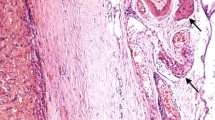Abstract
Myoepithelial carcinoma (MCA) is a rare malignancy of salivary glands that was included in the WHO Classification of Head and Neck Tumors in 1991. MCA has shown a broad spectrum of clinical outcomes, but attempts to identify prognostic markers for this malignancy have not resulted in significant progress. Conventional histopathological characteristics such as tumour grade, nuclear atypia, mitotic index and cell proliferation have failed to predict the outcome of MCA. In this study, we reviewed the histopathology of 19 cases of MCA focusing on nuclear atypia, mitotic count, tumour necrosis, nerve and vascular invasion and occurrence of a pre-existing pleomorphic adenoma in connection to the MCA. Histopathological characteristics and clinical information were correlated with the immunohistochemical expression of cell cycle proteins including c-Myc, p21, Cdk4 and Cyclin D3. The proportion of tumour cells immunoreactive for these markers and their intensity of staining were correlated with clinical information using logistic regression, Kaplan-Meier and Cox regression. Using logistic regression analysis, cytoplasmic c-Myc expression was associated with the occurrence of metastases (P = 0.019), but limitations of semi-quantitation of immunostaining and the limited number of cases preclude definitive conclusions. Our data show that the occurrence of tumour necrosis predicts poor disease-free survival in MCA (P = 0.035).


Similar content being viewed by others
References
Skalova A, Jakel K (2005) Myoepithelial carcinoma. In: Barnes L, Eveson J, Reichart P, Sidransky D (eds) World health organization classification of head and neck tumours. IARC, Lyon, pp 240–241
Savera AT, Sloman A, Huvos AG, Klimstra DS (2000) Myoepithelial carcinoma of the salivary glands: a clinicopathologic study of 25 patients. Am J Surg Pathol 24:761–774
Kane SV, Bagwan IN (2010) Myoepithelial carcinoma of the salivary glands: a clinicopathologic study of 51 cases in a tertiary cancer center. Arch Otolaryngol Head Neck Surg 136:702–712. doi:10.1001/archoto.2010.104
Kong M, Drill EN, Morris L, West L, Klimstra D, Gonen M, Ghossein R, Katabi N (2015) Prognostic factors in myoepithelial carcinoma of salivary glands: a clinicopathologic study of 48 cases. Am J Surg Pathol 39(7):931–938. doi:10.1097/PAS.0000000000000452, PubMed
Skálová A, Weinreb I, Hyrcza M, Simpson RH, Laco J, Agaimy A, Vazmitel M, Majewska H, Vanecek T, Talarčik P, Manajlovic S, Losito SN, Šteiner P, Klimkova A, Michal M (2015) Clear cell myoepithelial carcinoma of salivary glands showing EWSR1 rearrangement: molecular analysis of 94 salivary gland carcinomas with prominent clear cell component. Am J Surg Pathol 39(3):338–348. doi:10.1097/PAS.0000000000000364, PubMed
Weinberg R (2007) pRB and control of the cell cycle clock. In: Weinberg R (ed) The biology of cancer, firstth edn. Garland Science, New York, pp 255–306
Malumbres M, Barbacid M (2009) Cell cycle, CDKs and cancer: a changing paradigm. Nat Rev Cancer 9:153–166. doi:10.1038/nrc2602
Dominguez Sola D, Ying CY, Grandori C, Ruggiero L, Chen B, Li M, Galloway DA, Gu W, Gautier J, Dalla Favera R (2007) Nontranscriptional control of DNA replication by c-Myc. Nature 448:445–451. doi:10.1038/nature05953
Van Riggelen J, Yetil A, Felsher DW (2010) MYC as a regulator of ribosome biogenesis and protein synthesis. Nat Rev Cancer 10:301–309. doi:10.1038/nrc2819
Eilers M, Eisenman RN (2008) Myc’s broad reach. Genes Dev 22:2755–2766. doi:10.1101/gad.1712408
Nagao T, Sugano I, Ishida Y, Tajima Y, Matsuzaki O, Konno A, Kondo Y, Nagao K (1998) Salivary gland malignant myoepithelioma: a clinicopathologic and immunohistochemical study of ten cases. Cancer 83:1292–1299
Di Palma S, Guzzo M (1993) Malignant myoepithelioma of salivary glands: clinicopathological features of ten cases. Virchows Arch A Pathol Anat Histopathol 423:389–396
Cai C, Dehner LP, El-Mofty SK (2013) In myofibroblastic sarcomas of the head and neck, mitotic activity and necrosis define grade: a case study and literature review. Virchows Arch 463(6):827–836. doi:10.1007/s00428-013-1494-1, Epub 2013 Oct 17. Review. PubMed
Pichler M, Hutterer GC, Chromecki TF, Pummer K, Mannweiler S, Zigeuner R (2013) Presence and extent of histological tumour necrosis is an adverse prognostic factor in papillary type 1 but not in papillary type 2 renal cell carcinoma. Histopathology 62:219–228
Lohse CM, Cheville JC (2005) A review of prognostic pathologic features and algorithms for patients treated surgically for renal cell carcinoma. Clin Lab Med 25:433–464
Yanai H, Mani Y, Notohara K, Takada S, Yoshino T (2010) Uterine leiomyosarcoma arising in leiomyoma: Clinicopathological study of four cases and literature review. Pathol Int 60:506–509
Katabi N, Gomez D, Klimstra DS, Carlson DL, Lee N, Ghossein R (2010) Prognostic factors of recurrence in salivary carcinoma ex pleomorphic adenoma, with emphasis on the carcinoma histologic subtype: a clinicopathologic study of 43 cases. Hum Pathol 41:927–934. doi:10.1016/j.humpath.2009.12.011
Klein JD, Grandis JR (2010) The molecular pathogenesis of head and neck cancer. Cancer Biol Ther 9:1–7
Calcagno DQ, Leal MF, Assumpcao PP, Smith MA, Burbano RR (2008) MYC and gastric adenocarcinoma carcinogenesis. World J Gastroenterol 14:5962–5968
Vékony H, Röser K, Löning T, Ylstra B, Meijer GA, Van Wieringen WN et al (2009) Copy number gain at 8q12.1-q22.1 is associated with a malignant tumor phenotype in salivary gland myoepitheliomas. Genes Chromosomes Cancer 48:202–212
Etges A, Nunes FD, Ribeiro KC, Araujo VC (2004) Immunohistochemical expression of retinoblastoma pathway proteins in normal salivary glands and in salivary gland tumours. Oral Oncol 40:326–331
Vekony H, Roser K, Loning T, Raaphorst FM, Leemans CR, Van Der Waal I, Bloemena E (2008) Deregulated expression of p16INK4a and p53 pathway members in benign and malignant myoepithelial tumours of the salivary glands. Histopathology 53:658–666. doi:10.1111/j.1365-2559.2008.03184.x
Acknowledgments
The authors acknowledge financial support from the Finnish Cancer Society, Finska Läkaresällskapet and the Maritza and Reino Salonen Foundation. The technical assistance of Ms. Eija Heiliö and Ms. Tuija Järvinen is kindly acknowledged.
Author information
Authors and Affiliations
Corresponding author
Ethics declarations
Conflict of interest
The authors declare that they have no competing interests.
Rights and permissions
About this article
Cite this article
Passador-Santos, F., Grönroos, M., Irish, J. et al. Clinicopathological characteristics and cell cycle proteins as potential prognostic factors in myoepithelial carcinoma of salivary glands. Virchows Arch 468, 305–312 (2016). https://doi.org/10.1007/s00428-015-1889-2
Received:
Revised:
Accepted:
Published:
Issue Date:
DOI: https://doi.org/10.1007/s00428-015-1889-2




